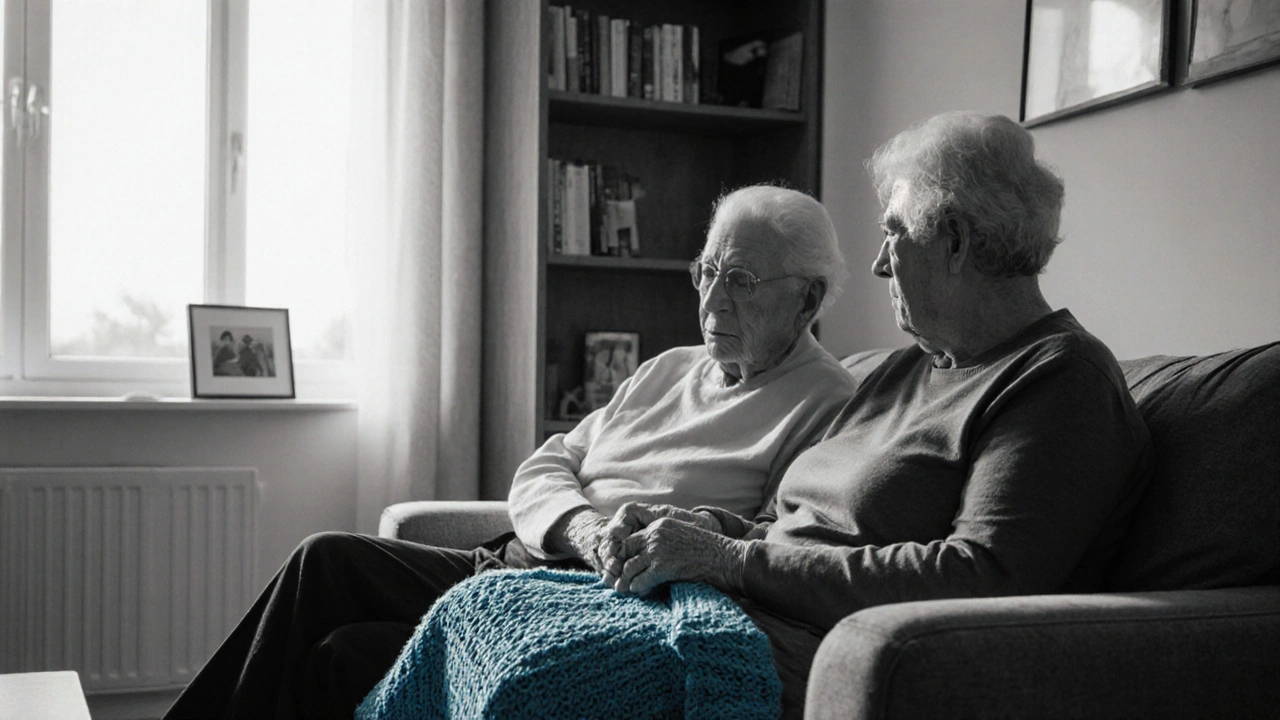When a loved one is living with Alzheimer’s‑type dementia, thinking about the final chapter can feel overwhelming. You’re not alone - families across the world wrestle with the same questions about comfort, dignity, and who makes the call when the person can no longer speak for themselves. This guide pulls together the medical, legal, and emotional pieces you need to create a clear, compassionate plan.
What is Alzheimer’s‑type Dementia?
Alzheimer's disease is a progressive neurodegenerative disorder that accounts for about 60‑70% of all dementia cases. It typically starts with short‑term memory loss and slowly spreads to language, reasoning, and eventually basic self‑care. The disease is marked by amyloid plaques and tau tangles in the brain, which interfere with neuron communication. While the medical trajectory is well documented, the personal experience varies widely - some families notice rapid decline, others see a slower pace over many years.
Defining End‑of‑Life Care for Dementia
In everyday language, end-of-life care means the support and medical services provided when a person is approaching the final stages of life. For someone with Alzheimer’s‑type dementia, this care focuses on comfort, symptom management, and maintaining quality of life rather than curative treatment. It blends palliative care a specialized approach that eases pain, shortness of breath, agitation, and other distressing symptoms while respecting the person's wishes with practical planning tools.
Key Decisions Families Face
When the disease reaches moderate to severe stages, families typically need to answer three big questions:
- Where will the person live? Home with home‑care aides, an assisted‑living community, or a specialized dementia unit?
- What medical interventions are appropriate? Do we continue hospitalizations for infections, or focus on comfort‑only measures?
- Who has the legal authority to make choices? Is there an existing healthcare proxy a trusted individual designated to decide on medical care when the patient can’t or do we need a court‑appointed guardian?
Answering these questions early, before the person loses decision‑making capacity, can dramatically reduce stress later on.
Advance Care Planning Tools Explained
Advance care planning (ACP) is the umbrella term for all documents that capture a person's preferences. The three most common tools are:
| Document | Legal Status (US/UK) | Main Focus | Who Can Create It? |
|---|---|---|---|
| Living Will | Recognized in most states, varies by province | Specifies treatments you want or don’t want (e.g., ventilation) | Capable adult |
| Durable Power of Attorney for Health Care | Widely accepted, must be notarized in many jurisdictions | Appoints a proxy to make decisions on your behalf | Capable adult |
| Do Not Resuscitate (DNR) Order | Medical order, valid only in hospitals/long‑term facilities | Directs staff not to perform CPR | Physician after patient or proxy request |
For Alzheimer’s patients, a living will can be completed while the person still understands the implications, and a healthcare proxy should be named early, preferably someone who knows the individual's values and daily routine.

Legal Considerations: Guardianship vs. Proxy
When a dementia patient never created an advance directive, the court may step in. A legal guardian a court‑appointed individual authorized to make personal and financial decisions for an incapacitated adult can be assigned, but this process can take weeks or months. In contrast, a healthcare proxy a person specifically chosen to make medical decisions on the patient’s behalf usually takes effect immediately after the patient signs the document, saving precious time during health crises.
Key steps to solidify legal authority:
- Complete the appropriate state or provincial form for a healthcare proxy.
- Witness the document according to local law (often two adult witnesses).
- Store a copy in an easily accessible place - with the primary care doctor, at home, and on a secure digital portal.
- If no proxy exists, consult an elder‑law attorney to start a guardianship petition.
Practical Steps for a Person‑Centered Care Plan
Putting everything together into a actionable plan looks like this:
- Gather the medical history. Collect recent scans, medication lists, and any notes from neurologists or geriatricians.
- Hold a family meeting. Choose a calm setting, lay out the current stage of dementia, and discuss values - e.g., does the person value independence over longevity?
- Designate the decision‑maker. Have the chosen proxy sign a durable power of attorney and review it with a lawyer.
- Document care preferences. Fill out a living will, specify DNR status if desired, and note comfort‑focused interventions (e.g., music therapy, aromatherapy).
- Choose a care setting. Evaluate home‑care agencies, memory‑care units, or hospice programs based on budget, proximity, and staff expertise.
- Set up symptom‑management protocols. Work with the palliative team to create orders for pain control, agitation management, and feeding preferences.
- Review and revisit. Every six months, or after any major health event, re‑evaluate the plan with the healthcare team.
Following this checklist helps keep the journey organized and reduces the emotional roller‑coaster that often hits families during crises.
Managing Symptoms in the Final Stages
As dementia advances, three symptom clusters dominate:
- Pain. Even when the person can’t verbalize it, signs like grimacing or restlessness signal discomfort. Low‑dose opioids, acetaminophen, or topical agents can be effective.
- Agitation &sundowning. Bright lights, background music, and a consistent daily routine often calm evening spikes. Sometimes a short‑acting antipsychotic is prescribed, but it should be a last resort.
- Difficulty swallowing. Consult a speech‑language pathologist early. If the risk of aspiration rises, discuss the option of a feeding tube versus comfort‑only hydration.
Palliative‑care teams specialize in these issues, offering 24‑hour nurse lines, medication titration, and emotional support for family members.

Communicating with the Healthcare Team
Clear communication saves a lot of heartache. Here’s a quick script you can use during appointments:
"We have a living will and a healthcare proxy in place. Our main goal now is comfort and dignity. Can you walk us through your approach to pain and agitation for someone in the moderate‑to‑severe stage of Alzheimer’s?"
Ask the clinician to write down any agreed‑upon orders (e.g., DNR, medication adjustments) and place them in the person’s chart. Request a copy for your records.
Common Pitfalls and Pro Tips
Pitfall 1: Waiting too long to appoint a proxy. By the time a crisis hits, the person may already be incapacitated and the legal process stalls.
Pro tip: Set the proxy before the diagnosis is confirmed. Even a “just in case” document can be amended later.
Pitfall 2: Assuming hospice = no treatment. Hospice focuses on comfort, but it still provides antibiotics, pain relief, and emotional counseling when appropriate.
Pro tip: Ask the hospice team to clarify which interventions they consider “comfort‑oriented” versus “curative.”
Pitfall 3: Ignoring cultural or spiritual preferences. Families often overlook values like prayer, family rituals, or preferences for at‑home death.
Pro tip: Bring a chaplain or cultural liaison into the care meeting early on.
Quick Takeaways
- Start advance‑care planning while the person still has decision‑making capacity.
- Use a living will, durable power of attorney, and DNR order to cover medical, legal, and comfort preferences.
- Designate a trusted healthcare proxy; this is faster and more flexible than a court‑appointed guardian.
- Partner with a palliative‑care or hospice team to manage pain, agitation, and swallowing issues.
- Revisit the care plan regularly; dementia progression isn’t linear.
Frequently Asked Questions
Can I change a living will after I’ve signed it?
Yes. Most jurisdictions allow you to revoke or amend a living will at any time while you’re still competent. Keep the newest version with your other documents and let your healthcare proxy know about the change.
What if my loved one never signed any advance‑care documents?
In that case, a court may need to appoint a legal guardian. This process can be lengthy, so many families start a guardianship petition as soon as capacity is lost, while simultaneously asking the medical team to follow the patient’s known wishes as best as possible.
Is hospice care only for the last two weeks of life?
Hospice eligibility typically requires a prognosis of six months or less if the disease follows its usual course. However, many people remain in hospice for longer, especially with conditions like Alzheimer’s where the trajectory can be unpredictable.
How do I know if my family member is in pain when they can’t speak?
Watch for non‑verbal cues: clenched fists, rapid breathing, facial grimacing, or pulling away from touch. A pain assessment tool designed for dementia, like the PAINAD scale, can help quantify discomfort.
Should we consider feeding tubes for someone with advanced Alzheimer’s?
Research shows feeding tubes don’t improve survival or quality of life for advanced dementia patients. Most guidelines recommend comfort feeding-offering soft foods or liquids as tolerated and focusing on hydration.

andrew bigdick
October 15, 2025 AT 20:21Got the guide loaded up and it really pulls the pieces together-medical facts, legal forms, and a step‑by‑step care plan all in one place. It’s the kind of roadmap families need when the dementia fog starts to settle in.
Leon Wood
October 15, 2025 AT 20:38Exactly, having that checklist makes the whole thing feel less like a nightmare and more like a project you can actually manage.
Hang in there, you’ve got this.
Sherine Mary
October 15, 2025 AT 21:03Honestly, the guide re‑hashes what any decent hospice nurse would tell you in a whisper, yet it dresses it up in fancy headings. The legal jargon is more confusing than helpful, and the emotional tone feels like a self‑help pamphlet for people who want to feel virtuous without doing the real work.
Monika Kosa
October 15, 2025 AT 21:36Anyway, have you ever noticed how the pharmaceutical companies seem to push those pricey palliative meds right when the guardianship paperwork is being filed? It’s like they’re timing the profit spikes with the family’s legal headaches. Just saying.
Maureen Crandall
October 15, 2025 AT 21:53Saved the quick‑look checklist.
rafaat pronoy
October 15, 2025 AT 22:10😉 The checklist is solid, especially the part about storing copies in three places. Keeps the paperwork from disappearing into the abyss.
Shelby Wright
October 15, 2025 AT 22:43The first thing that hits you when you read a guide like this is the raw, unfiltered grief that families carry around like an invisible backpack. You can’t just tick boxes and pretend the emotional toll isn’t there; each decision is a tiny surrender of hope and a massive affirmation of love. When you choose a care setting, you’re also choosing which moments you’ll get to hold a hand, which rooms will see the last shared jokes, and which staff will become part of the family’s daily rhythm. The medical jargon about amyloid plaques and tau tangles feels detached, but the real battle is over whether to chase a tube or let nature take its course. The guide’s section on DNR orders is a blunt reminder that we all have to face mortality, yet it also honors the dignity of a person who once could speak their mind. Legal proxies aren’t just legalese; they’re the people who will sit at the bedside and say, “I’ve got you,” when the patient can’t. The part about palliative‑care teams offering 24‑hour nurse lines is a lifeline that many families overlook until the crisis hits. It’s fascinating how a simple music playlist can calm sundowning-a reminder that the human brain still responds to rhythm even when memory fades. The guide talks about feeding tubes, but the real conversation is about keeping the person’s favorite foods on the table as long as possible. I love how the checklist circles back to reviewing the plan every six months, because dementia is a moving target, not a static diagnosis. And let’s not forget the cultural and spiritual side-bringing a chaplain or a cultural liaison early on can prevent a lot of later friction. All in all, this guide is less about a sterile protocol and more about weaving a tapestry of medical facts, legal safeguards, and heartfelt moments. It’s a reminder that even in the darkest chapters, there’s room for compassion, intentionality, and a little bit of stubborn optimism. So, grab a pen, make those calls, and keep the conversation alive-because the silence is the real enemy.
Ellen Laird
October 15, 2025 AT 23:00Well, your poetic avalanche certainly dazzles, though one might argue that a dash of concision could spare the reader from drowning in sentimentality.
sachin shinde
October 15, 2025 AT 23:33The guide’s language oscillates between white‑paper bore and layman’s drivel, a linguistic tightrope that could use a sharper edit. In legal sections, “must” and “shall” are interchanged without regard for jurisdictional precision, and the occasional dangling modifier makes the document feel like a student essay. Also, the over‑use of passive voice in the symptom‑management protocols strips agency from caregivers, which is counter‑productive. A quick proofread would eliminate the stray commas after bullet points and harmonize the capitalization of headings. Clarity is a form of compassion, after all.
George Embaid
October 16, 2025 AT 00:06From a cultural standpoint, the guide does a decent job of mentioning chaplains, but many families rely on community elders, traditional healers, or home‑based rituals that aren’t captured in the standard hospice model. Including a note about how to integrate those practices can make the plan feel less foreign and more respectful of diverse backgrounds.
Shivaraj Karigoudar
October 16, 2025 AT 00:40Delving into the legal labyrinth, it’s crucial to distinguish between a durable power of attorney for health care and a full guardianship order; the former is activated by the principal’s signature, while the latter requires a judicial decree after capacity loss. Many states also demand two disinterested witnesses or a notary, and failure to meet those formalities can render the document invalid when the stakes are highest. Additionally, the timing of filing the proxy with the primary care office versus the hospital can affect how quickly the medical team acknowledges the surrogate’s authority. It’s advisable to cross‑reference the state’s health‑care surrogate statutes-some jurisdictions, like California, have specific “Advance Health Care Directive” forms that integrate both living will and proxy elements. For families contemplating cross‑border care, be aware that the UK’s “Lasting Power of Attorney” has different activation criteria and may not be recognized in the US without a formal International Health Care Directive. Lastly, keep a digital copy on a secure cloud service with end‑to‑end encryption; that ensures accessibility even if the physical copies are misplaced during a move to a memory care facility.
Matt Miller
October 16, 2025 AT 00:48Bottom line: file the proxy, get notarized, store three copies.
Fabio Max
October 16, 2025 AT 01:13Great points-all these steps feel less intimidating when broken into bite‑size actions.
Darrell Wardsteele
October 16, 2025 AT 01:46The guide’s American‑centric bias ignores the fact that many countries have universal palliative systems that make these forms redundant. Also, the inconsistent use of “DNR” versus “Do Not Resuscitate” is sloppy; pick one term and stick to it. And don’t forget to spell “rehabilitation” correctly.
Andrea Rivarola
October 16, 2025 AT 02:03I hear you on the international angle, and I’d add that the terminology differences can actually cause real‑world delays when hospitals need to verify a patient’s wishes. It’s worth including a quick reference table for common equivalents across major health systems, like NHS, Medicare, and Canada’s provincial plans. That way, families won’t get tangled up in bureaucratic red tape while the person needs immediate comfort care.
Ryan Wilson
October 16, 2025 AT 02:36Everyone should take a moment to consider the moral weight of choosing comfort‑only care versus extending life at any cost. It’s not just a medical decision; it’s a reflection of the values we hold about dignity, autonomy, and the sanctity of the human experience.
EDDY RODRIGUEZ
October 16, 2025 AT 02:53Well said! Let’s keep the conversation focused on respecting the person’s legacy while providing the relief they deserve. Together we can turn these tough choices into acts of love.
Henry Clay
October 16, 2025 AT 03:26At the end of the day, no amount of paperwork can replace the simple truth that caring for a loved one with dementia is a test of our humanity and compassion 😊